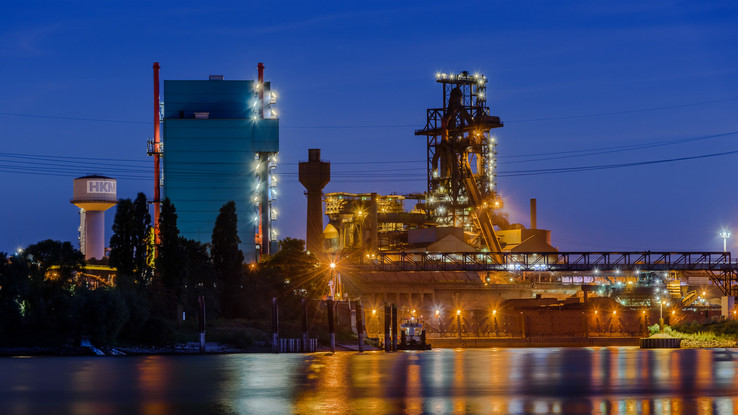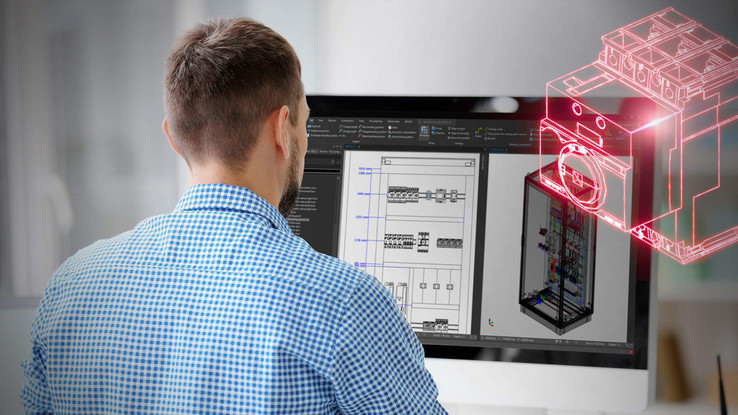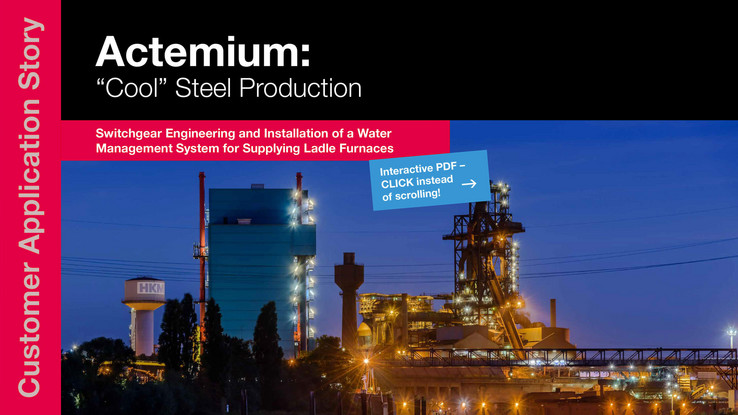"Cool" Steel Production
Switchgear Engineering and Installation of a Water Management System for Supplying Ladle Furnaces
Ladle furnaces supplied with cooling power via a connected water management system are one of the many devices used in steel production. The Hüttenwerke Krupp Mannesmann (HKM) steelworks in Duisburg, Germany, has exactly this sort of setup. In 2019, ME Engineering based in Marl, Germany – a company in the Actemium network – was awarded the contract, via plant engineering company AMR Engineering, to provide the entire scope of electrical equipment and services, including software development, for HKM’s new water management system. This system is part of the two new ladle furnaces that are to be built onsite at HKM. The full scope of services was put together as part of a team effort led by Actemium Division Rhein-Ruhr.
According to statistics collected by statista.com, around 40 million tonnes of raw steel was manufactured in Germany in 2019 – a considerable percentage of which came from the Hüttenwerke Krupp Mannesmann (HKM) steelworks in Duisburg, Germany. To ensure that the steel production facilities there continue to meet state-of-the-art requirements, it was necessary to expand the existing electrotechnical installations for the water management system used to cool the two ladle furnaces at HKM. Aside from all the engineering for the instrumentation and control (I&C) technology and the software, the overall contract also included delivery of the low-voltage (LV) switchgear system, an uninterruptable power supply (UPS) and the process control technology, including remote I/O systems. On top of this was also the complete installation and final commissioning, not to mention an update of the control systems for the existing plant systems. The Actemium Division Rhein-Ruhr, which was awarded this overall contract, has offices in the German cities of Marl, Essen, Duisburg, Bottrop, Kerken and Wetter.
Planning on the Digital Drawing Board
Working with Actemium Bottrop, ME Engineering planned both a new 2,000 A LV switchgear system and the automation control cabinets using the CAE solution EPLAN Electric P8 and the software tool EPLAN Pro Panel in 3D. The engineering, specifically the control cabinet layouts, was accomplished in 3D with the help of detailed manufacturer libraries, and the control cabinet drawings were integrated into the switchgear system production throughout, thus shortening the overall time required for the project. The reason: because the client was provided a precise overview and layout of the new control cabinets at an early stage in the project, the dimensions for planning the space, as well as information about heat loss, could be viewed and also verified right away. This meant that decisions could be made more quickly in close consultation with the client and mistakes could be avoided at an early stage.



Updating the Existing Systems
The next step was to migrate the control system for the existing plant systems. This was carried out using the current process control system Simatic PCS 7 from Siemens in a virtual environment, which makes it possible to construct the entire plant in Profinet as far as the fieldbuses are concerned. In this case, this meant a new decentralised peripheral system and all frequency converters for the highly available automation systems. Instead of the traditional horizontal installation of the input and output cards in the switchgear system, these were installed vertically in the marshalling cabinets. This layout saved a considerable amount of space – for example, reducing the number of cabinets from two to one – and made optimal use of the available space in the transformer house, as well as eliminating the need for a separate cooling unit. At the same time that the existing plant systems were being migrated to state-of-the-art control system infrastructure, the control system for the new water management system was being enhanced and expanded in collaboration with AMR Engineering.
Installation and Final Commissioning
As part of a direct contract from the end client HKM, Actemium Bottrop delivered a low-voltage main power distribution system, including two medium-voltage transformers. This was followed by the complete electrical installation both outside and within the transformer houses. Amongst other things, the feed for the new LV distributors now runs directly from the feeders of the low-voltage main power distribution system. Actemium Division Rhein-Ruhr has thus supplied all the equipment onsite, from the medium voltage system to the connection of the actuators and sensors.
The commissioning of the entire system took place in September and October of 2019 and, thanks to the successful trial operations and subsequent on-call service, was ultimately finalised in mid-2020. The completion of the contract means that HKM is reaping the benefits of future-proof systems, increased data security for its plant systems IT, improved operational capabilities and, thanks to the 3D engineering, space savings within the transformer houses.
Author: A. Schulze Forsthövel, ME Engineering



